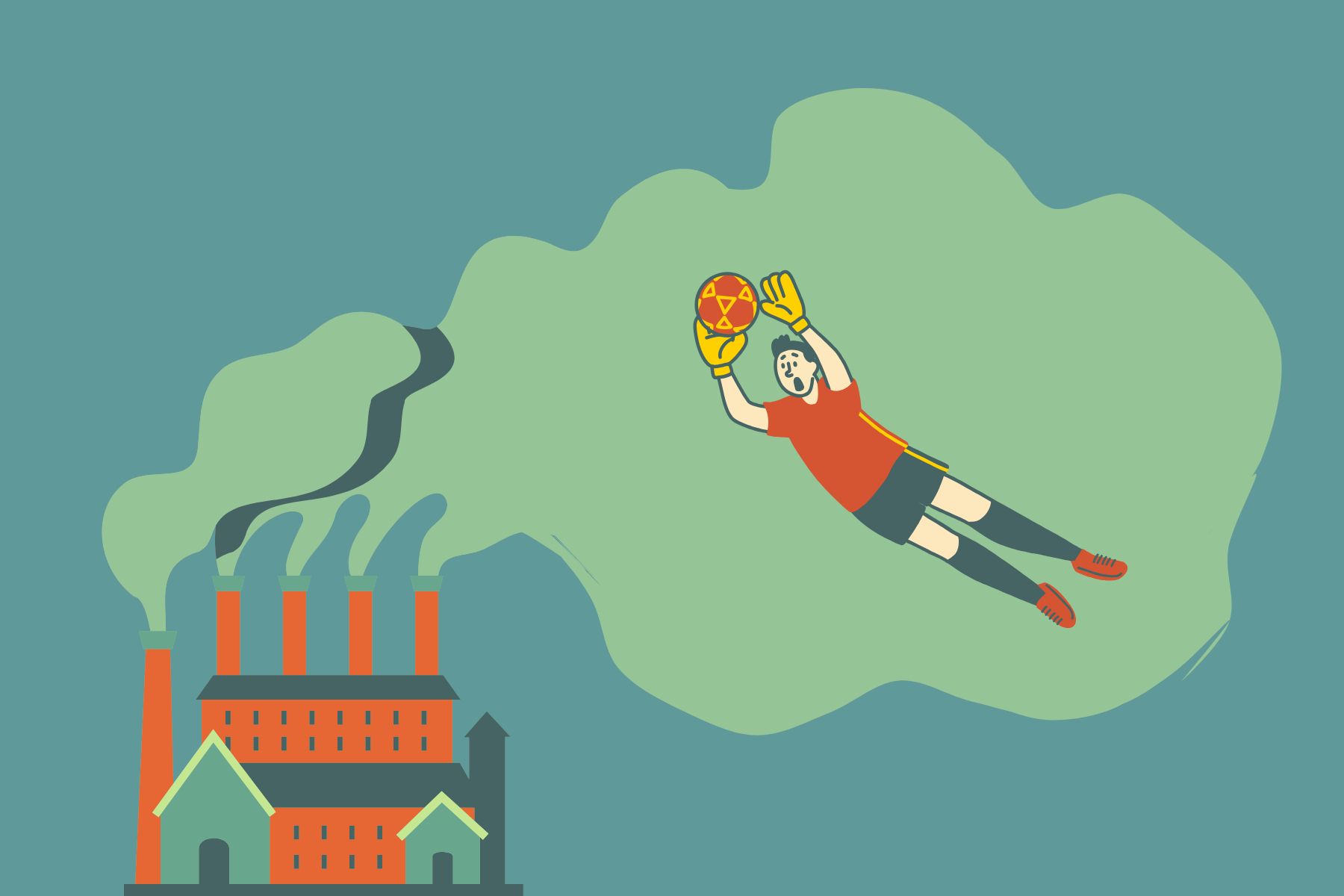Varsity sports can’t keep contributing to the climate crisis

Graphic by Sage Blackwell.
The sports industry and climate change are inextricably linked. One estimate reports that the 600-billion-dollar global sports industry is responsible for a total of 350 million tons of CO2e (carbon emissions) per year. For context, the average car emits about 4.6 tons of CO2e per year, whereas the entire nation of France produces around 315 million tons.
The irony is that sport relies completely on the climate — on clean air, clean water, and a safe place to play. Nowadays, whether from rising global temperatures and heat waves to fires, diminishing air quality, and flooding, climate change is frequently altering where, when, and how sports are played.
With this in mind, sport organizations must find ways to reduce their environmental footprint. Though global sporting events and major professional leagues such as the NFL account for the industry’s most looming impacts, local and regional sports such as Vikes varsity athletics must also consider their part in the climate equation.
UVic Executive Director of Wellness, Recreation and Athletics (WRA) Nicole Greengoe said the department — which oversees Vikes varsity athletics programs — is “committed to aligning with UVic’s broader climate action goals and sustainability strategies.” But what the department doesn’t have, Greengoe said, is a standalone carbon budget, or a method of recording and monitoring their carbon footprint.
For a university that touts itself as one of the world leaders in sustainability, it’s an avenue where we are firmly behind our peers. The University of British Columbia (UBC), by comparison, has already published research on its environmental performance at UBC Athletics and Recreation sporting events. Using a Life Cycle Assessment (LCA) based approach, which analyzes the environmental impact of an activity or program over its entire life cycle, UBC tracked their varsity teams’ energy consumption, water use, and waste recycling, alongside spectator and team travel, to generate an overall carbon footprint.
UVic would undoubtedly benefit from similar research as a starting point for better understanding the climate impact of Vikes varsity sports. It’s a logical first step. To strategically reduce the environmental impact of a given department, it’s crucial to first define how much of an impact is present.
One of the largest carbon contributors within college and professional athletics is travel. According to Greengoe, the majority of the Vikes regular season takes place regionally and does not require air travel, with the exception of international exhibition events and national championships that take place all over the country.
However, those international exhibitions can, at times, be a considerable contributor to the Vikes footprint. For example, over the last two years, the Vikes men’s basketball team has travelled to the Bahamas to play pre-season games. A round trip from Victoria to Nassau emits an estimated 658 kg of CO2e per passenger. According to UBC, that’s more than ten times the average per athlete emissions for one event.
Both the men’s and women’s basketball teams (who travel together) also fly to all regular season away games beyond the island and lower mainland, including separate air travel to Kamloops and Kelowna — two cities that are relatively close by charter bus.
Air travel for short distances is particularly harmful to the environment because emissions are highest during takeoff and landing. For example, the approximate distance of a flight from Vancouver to Kamloops will emit almost 500 times more CO2 per passenger than a charter bus would for the same trip.
UBC’s research on its varsity teams confirms this idea. Tracking the travel of 23 varsity teams over 502 games, their research determined that UBC athletics generated around 630 tonnes of CO2e per year, with air travel making up the majority of the teams’ carbon footprint.
However, this carbon output is not solely the responsibility of varsity athletes. We, as spectators, also contribute to the emissions of our beloved teams. While the UBC athletics program may have generated 630 tons of CO2e in a single season, their fans generated a whopping 960 tonnes.
There are ways that fans can help reduce their environmental impact in regards to athletics. There are also ways that varsity programs can push their fan bases in the right direction. In the 2010 Olympics, for example, the City of Vancouver issued free bus passes to all ticket-holders, which led to a 40 per cent increase in bus use during the games. Universities could and should look into implementing similar programs for their non-student fan bases.
While Vikes varsity athletics and WRA could do a better job monitoring and defining how much of an overall environmental impact it creates, the department is also already implementing strategies for sustainability.
CARSA, where the Vikes basketball teams play, is one of nine buildings on UVic’s campus with LEED (Leadership in Energy and Environmental Design) Gold certification — earned by using green building strategies — and reportedly includes technologies to reduce water consumption by 40 per cent. CARSA also generates half of its energy for cooling and heating using a geothermal system.
Specific programs, too, have made strides towards greater environmental consciousness. The Vikes women’s rowing team, for example, have recently begun a partnership with WinTech, a boat manufacturing company whose factory is almost entirely operated via solar power and claims to produce zero air pollution.
Other department initiatives include reducing sports equipment waste by selling operational equipment on BC Bid, and repurposing other equipment for campus groups such as the engineering department, where parts are used in student projects.
As the climate crisis worsens, the question of how much our society should prioritize sport over the environment will only get louder. For athletes and fans alike, the message should be clear — play sustainably, or risk not playing at all.








